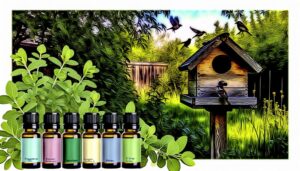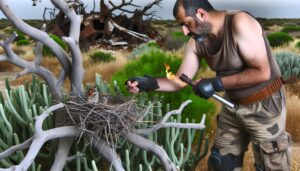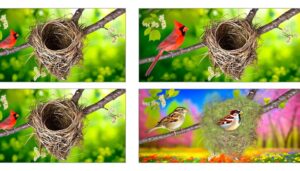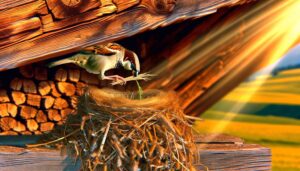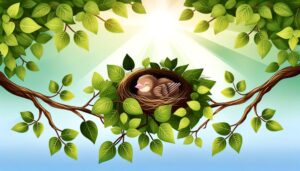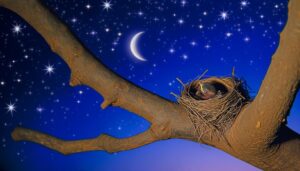5 Steps to Find Sparrow Nests
To find a sparrow nest, focus on early spring and observe sparrows at dawn or dusk. Use binoculars to spot nests in urban building eaves, garden shrubs, or nesting boxes.
Identify sparrows by their size, plumage patterns, and vocalizations. A keen ear helps; listen for their distinct calls using a field recorder if needed.
Document their nest-building materials, like twigs and leaves, in your field notebook. Track behaviors such as courtship displays.
Stay observant, respect their habitats, and you'll discover intricate nesting patterns and behaviors. There's much more to uncover in this fascinating process.

Key Takeaways
- Check Urban Building Eaves: Look for nests in protected areas like urban building eaves where sparrows seek shelter and food proximity.
- Inspect Garden Shrubs: Examine dense garden shrubs that provide cover and concealment against predators for sparrow nests.
- Monitor Nesting Boxes: Observe nesting boxes closely as sparrows often use them for controlled nesting environments.
- Identify Nest Materials: Search for nests made of grasses, twigs, feathers, and other materials typically used by sparrows.
- Observe Early and Late: Conduct observations during early mornings and late afternoons when sparrows are most active in nest-building.
Best Time to Search

During the early spring months, you'll observe increased sparrow activity as they begin their nesting season. This period is ideal for locating nests.
Focus your search during dawn or dusk when sparrows are most active. Equip yourself with binoculars and a field notebook to record observations meticulously.
Look for sparrows carrying nesting materials like twigs and grass, as this indicates nest-building sites. Pay attention to dense shrubbery, tree branches, and building eaves, which are preferred nesting locations.
Approach quietly to avoid disturbing them and compromising their safety. By understanding their nesting schedule and habitat preferences, you can effectively pinpoint sparrow nests, contributing to both your study and conservation efforts.
Your detailed observations can aid in ensuring the well-being of these avian creatures.
Understanding Sparrow Behavior
To effectively pinpoint sparrow nests, it's necessary to understand their behavior, including their social interactions, feeding patterns, and nesting habits.
Sparrows are highly social, often forming flocks. Observe their communal roosting sites at dusk, typically in trees or shrubs. Note their foraging routines; they frequently return to the same locations for food, such as gardens or bird feeders.
Sparrows prefer nesting in cavities or dense foliage. During the breeding season, watch for males performing courtship displays and carrying nesting materials. Track these activities to locate potential nesting sites.
Utilize binoculars and keep detailed field notes to document behaviors and patterns. By thoroughly observing these habits, you'll increase your chances of successfully identifying sparrow nests.
Identifying Sparrow Species
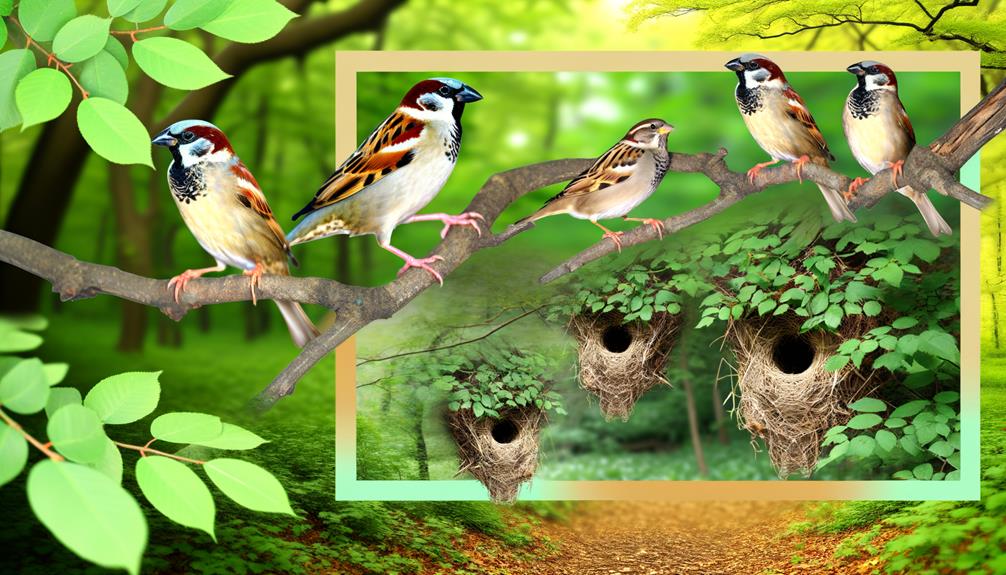
When identifying sparrow species, you should focus on common traits such as size, plumage patterns, and vocalizations.
Observe their habitat preferences closely, as some sparrows favor urban settings while others prefer grasslands or wetlands.
Utilize binoculars and field guides to make precise identifications in various environments.
Common Sparrow Traits
Identifying sparrow species involves closely examining their size, plumage patterns, and distinctive calls, often requiring a field guide and binoculars for accurate observation. Notice the sparrow's overall length, typically ranging from 12 to 15 centimeters.
Observe plumage details; House Sparrows exhibit grey crowns and black bibs, while Song Sparrows display streaked breasts with a central spot. Listen for their calls: House Sparrows emit a simple, monotonous 'chirp,' whereas Song Sparrows produce a complex, melodious series of notes.
Use your field guide to compare these traits, noting any unique markings or behaviors. Binoculars will help you see finer details, enhancing your ability to distinguish between similar species. This precise identification aids in serving conservation efforts and community education.
Habitat Preferences
In urban and suburban settings, House Sparrows often favor nesting sites in man-made structures such as eaves, vents, and building crevices. You can identify their nests by observing small, untidy collections of grass, feathers, and paper. When surveying for nests, use binoculars to scan ledges and openings.
In contrast, Tree Sparrows prefer rural areas, often selecting cavities in old trees or birdhouses. Observing their preference for natural materials like twigs and moss can help you differentiate between species. Field methods include maintaining a respectful distance to avoid disturbing the birds.
Record your findings systematically, noting location, materials, and bird behavior. By understanding these habitat preferences, you'll efficiently locate and study sparrow nests to aid in conservation efforts.
Common Nesting Sites
When searching for sparrow nests, you should examine urban building eaves, garden shrubs, and nesting boxes. Sparrows favor these sites due to their shelter, protection from predators, and proximity to food sources.
Use binoculars and a field notebook to document nest locations and characteristics.
Urban Building Eaves
Sparrows frequently select the eaves of city buildings as nesting sites because of the protection from predators and the elements. You'll want to focus on structures with overhanging roofs, ledges, or any crevices.
Early morning is ideal for observation; listen for chirping and watch for frequent avian activity. Use binoculars to examine potential nesting materials like twigs, feathers, and grass within these spaces. Document the locations and behaviors meticulously.
If you're assisting a conservation effort, make sure minimal disturbance to the birds. When you discover a nest, record the exact coordinates and note the building's characteristics, such as height and material. This data can help in monitoring and supporting urban sparrow populations effectively.
Garden Shrubs
Beyond the bustling cityscape, garden shrubs offer another favored nesting site for sparrows, providing ample cover and food sources. You'll want to observe dense, low-lying shrubs like privet, hawthorn, and boxwood. Sparrows prefer these for the concealment they offer against predators.
To locate a nest, approach quietly and watch for sparrow activity early in the morning when they're most active. Note any repetitive flight patterns into the shrubbery. Examine the shrub's interior carefully without disturbing the foliage. Look for small, cup-shaped nests made from twigs, grasses, and feathers.
Document your findings with notes and photographs, ensuring minimal disruption. By following these methods, you'll effectively assist in monitoring and conserving sparrow habitats.
Nesting Boxes
Installing nesting boxes in your garden provides a controlled environment for observing sparrow nesting behaviors and contributes to their conservation. Position the boxes at a height of 6 to 10 feet, facing away from prevailing winds to ensure stability and protection. Confirm the entrance hole is about 1.25 inches in diameter to accommodate sparrows while deterring larger species.
Monitor the boxes regularly, documenting any nesting material such as grasses, feathers, and twigs. Record observations of courtship displays, egg-laying, and chick development. Clean the boxes annually to prevent parasite buildup and enhance nesting success.
Offering supplementary food like seeds nearby can attract sparrows more readily. Your efforts not only aid scientific understanding but also support local sparrow populations effectively.
Recognizing Nesting Materials
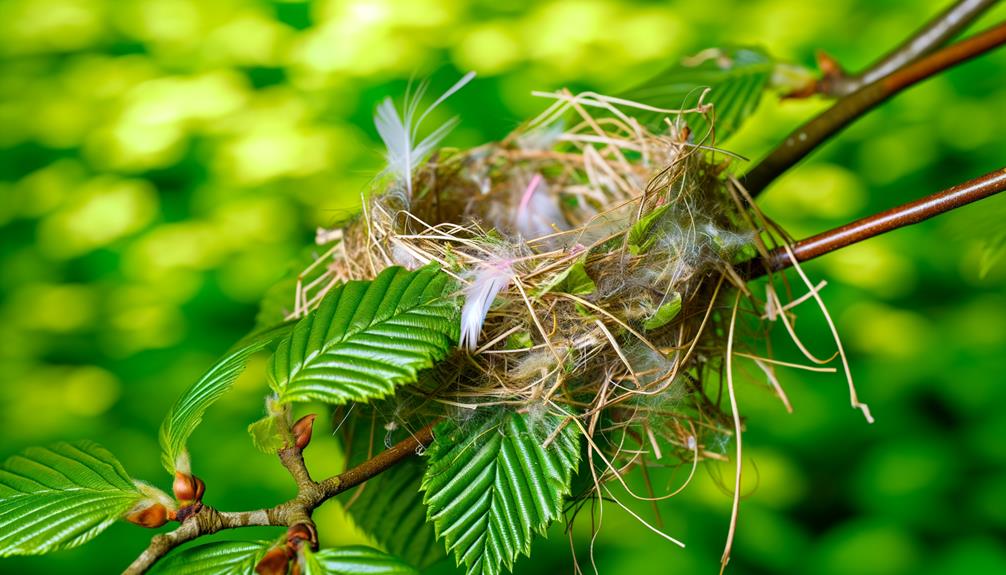
A sparrow's nest typically incorporates materials like grasses, twigs, and feathers, which you can identify through detailed observation and systematic field methods. Begin by examining areas where sparrows are frequently seen. Look for the following materials:
- Grasses: Often dry and thin, forming the nest's base.
- Twigs: Small branches that provide structure and support.
- Feathers: Both small and large, used for insulation.
- Paper and String: Occasionally incorporated for added stability.
- Leaves: Dried leaves that add camouflage and comfort.
Carry a field notebook to document your findings and use binoculars for a closer look without disturbing the habitat.
Observing Sparrow Activity
To observe sparrow activity effectively, focus your attention on their feeding and flight patterns, as well as vocalizations, during different times of the day. Begin by documenting when sparrows primarily feed, noting their preferred food sources and locations.
Track their flight trajectories from these feeding sites, as these often lead to nesting areas. Pay attention to their vocalizations, which can indicate feeding, alarm, or nesting behaviors. Utilize binoculars for a closer inspection and record your observations systematically.
Early mornings and late afternoons are ideal times, as sparrows are most active. By understanding their daily routines, you'll pinpoint potential nesting sites more precisely. This methodical approach guarantees you're thorough in your quest to find and protect sparrow nests.
Listening for Sparrow Calls
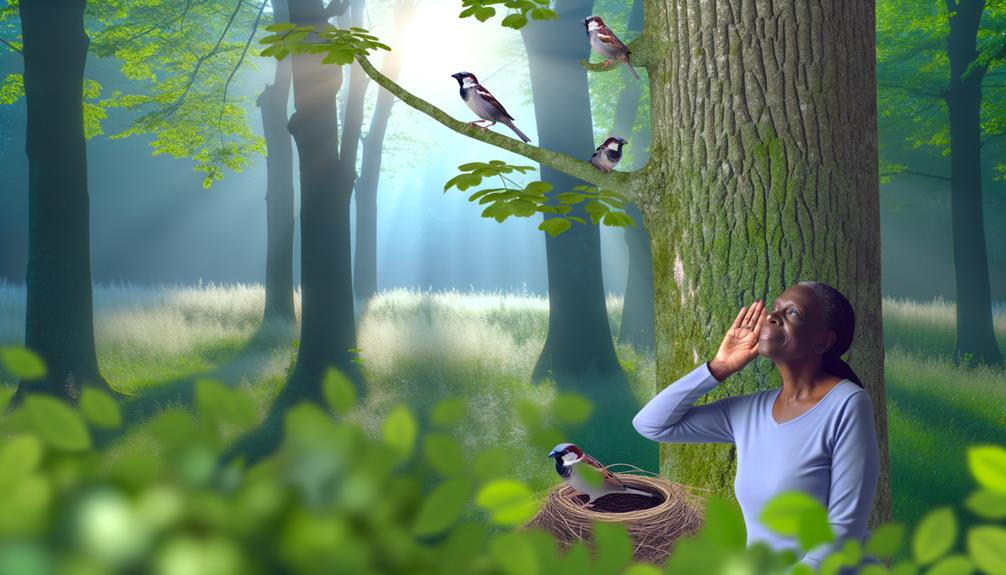
Begin by familiarizing yourself with the distinct vocalizations of sparrows, including their characteristic songs and calls.
Use a field recorder to capture and analyze call patterns, noting frequency, rhythm, and modulation.
Employ triangulation techniques to pinpoint the origins of chirping, enhancing your ability to locate nests with auditory cues.
Recognizing Sparrow Songs
Listening for sparrow calls involves identifying distinct vocal patterns and pitches characteristic of different sparrow species. You'll need to develop a keen ear for these subtle differences.
Sparrows exhibit a variety of songs and calls, each serving unique purposes such as marking territory or signaling alarm.
To effectively recognize sparrow songs, consider the following field methods:
- Frequency Analysis: Focus on the pitch and repetition rate.
- Behavioral Observation: Note the context in which calls are made.
- Use of Technology: Employ audio recording devices for playback and analysis.
- Reference Materials: Compare with bird song libraries and apps.
- Field Journals: Maintain detailed logs of observations and locations.
Identifying Call Patterns
By carefully noting the rhythm, pitch, and repetition of sparrow calls, you can start to distinguish between species-specific patterns.
Listen attentively to the cadence; house sparrows often produce a sharp 'chirrup' sequence, while song sparrows emit a complex, melodic tune.
Use a field recorder to capture these sounds, then analyze the frequency and intervals.
Pay attention to pitch variations; some species exhibit higher or lower tonal ranges.
Document your observations meticulously in a field journal, noting time, weather, and location.
Consistent repetition of specific calls can indicate nesting activity.
By mastering these auditory cues, you assist others by contributing to citizen science projects and aiding in avian conservation efforts.
Your thorough fieldwork guarantees precise identification and supports ecological research.
Locating Chirping Sources
When you're out in the field, position yourself in a quiet area early in the morning to improve your chances of pinpointing the exact location of sparrow calls. Sparrows are most vocal during dawn, making it the best time for auditory detection.
Listen attentively and practice triangulation by moving incrementally closer to the sound source.
Use these methods to assist your efforts:
- Stay still: Reduce movement to avoid startling the birds.
- Cup your ears: Amplify distant sounds by cupping your hands around your ears.
- Record audio: Utilize a portable recorder to capture calls for later analysis.
- Isolate frequencies: Focus on high-pitched, repetitive chirps typical of sparrows.
- Note patterns: Identify consistent chirping intervals to locate active nests.
Using Binoculars Effectively
To spot sparrow nests with precision, hold your binoculars steadily and adjust the focus until the image is sharp and clear. Start by scanning the area systematically, moving from one quadrant to another.
Pay attention to the sparrow's behavior; look for frequent trips to a particular location, which often indicates a nesting site. Observe the structure of trees, shrubs, or buildings, focusing on crevices and dense foliage where sparrows typically nest.
Note the nest material; sparrows use grasses, feathers, and twigs. Adjust the diopter setting on your binoculars to match your vision, ensuring both eyes see equally clearly. Practice patience and perseverance, as spotting nests requires time and careful observation.
Respecting Sparrow Habitats
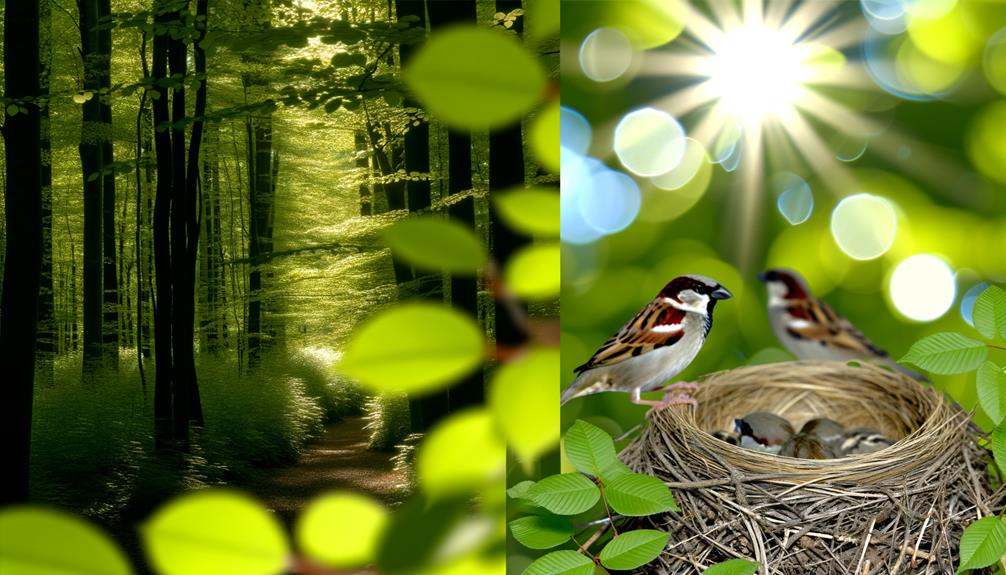
After locating a sparrow nest, exercise caution to minimize disturbance and protect the delicate ecosystem. Make sure to keep a safe distance to avoid causing stress to the birds. Use quiet, deliberate movements to prevent startling them. Document your observations quickly and efficiently, then withdraw to allow the sparrows to resume normal activities.
Maintain a buffer zone: Stay at least 10 meters away from the nest.
Limit observation time: Spend no more than 15 minutes near the nest.
Avoid touching: Don't handle the nest or chicks.
Minimize noise: Keep conversations and movements low and slow.
Leave no trace: Take all belongings and litter with you.
Recording Your Findings
Document your findings meticulously by noting the nest's exact location, number of sparrows, and any observed behaviors. Use a GPS device to record coordinates precisely.
Count the sparrows and note their age stages—adult, juvenile, or fledgling. Observe feeding patterns, vocalizations, and interactions among sparrows.
Record the type of nest and materials used. Take clear photographs for visual documentation and future reference.
Create a detailed field journal entry for each visit, including date, time, weather conditions, and any changes observed since the last visit.
Share your findings with local wildlife organizations to contribute to conservation efforts. Your meticulous records can aid researchers and enthusiasts in understanding sparrow behavior and habitat needs better, ultimately helping in their preservation.
Conclusion
In your quest to find a sparrow nest, remember to be patient and observant.
For instance, during a spring morning in Central Park, you might spot a House Sparrow darting into a shrub with grass strands in its beak.
Using your binoculars, you'll likely see its carefully constructed nest.
Always respect their habitat, maintaining a safe distance.
By recording your findings, you contribute valuable data to avian studies, enhancing our collective understanding of these resilient birds.

